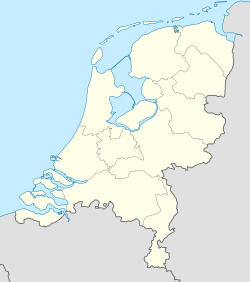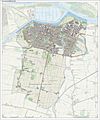Oud-Beijerland facts for kids
Quick facts for kids
Oud-Beijerland
|
|||
|---|---|---|---|
|
Town
|
|||

Old city hall
|
|||
|
|||
| Country | Netherlands | ||
| Province | South Holland | ||
| Municipality | Hoeksche Waard | ||
| Merged | 2019 | ||
| Area | |||
| • Total | 19.61 km2 (7.57 sq mi) | ||
| Elevation | 0.2 m (0.7 ft) | ||
| Population
(2021)
|
|||
| • Total | 24,670 | ||
| • Density | 1,258.0/km2 (3,258.3/sq mi) | ||
| Demonym(s) | Oud-Beijerlander | ||
| Time zone | UTC+1 (CET) | ||
| • Summer (DST) | UTC+2 (CEST) | ||
| Postal code |
3260–3263
|
||
| Dialing code | 0186 | ||
Oud-Beijerland is a town in the western part of the Netherlands. It is located in the province of South Holland. Today, it is part of the Hoeksche Waard municipality.
With about 24,575 people living there in 2020, it is the biggest town on the Hoeksche Waard island. The town is found right where the Oude Maas and Spui River meet. The smaller communities of Vuurbaken and Zinkweg are also part of Oud-Beijerland.
History
A very big flood happened in 1421, called the St. Elizabeth's flood (1421). This flood caused large areas of land to be lost. These lands became muddy areas that would flood when the tide was high. Because of this, people could not live there.
Over the next few centuries, people worked hard to get parts of this land back. This process is called land reclamation.
Oud-Beijerland was created in 1559. It was first called "Beijerland." A person named Lamoral, Count of Egmont, was given the rights to this area in 1557. He then had the land reclaimed from the water. This new piece of reclaimed land was called a polder. It was named Beijerland, Moerkerken, Cromstrijen en de Greup. Around 1624, two smaller polders, Bosschenpolder and Nieuwlandpolder, were added. The name Beijerland came from Sabina of Bavaria, who was the wife of Count Egmont.
In 1582, the town's name was changed to Oud-Beijerland. This was done to tell it apart from Nieuw-Beijerland, which was built a few kilometers to the west. "Oud" means "old" in Dutch, and "Nieuw" means "new."
In 1604, Sabina van Beijeren gave the village its church tower. Then, in 1622, the town hall was built. Oud-Beijerland became one of the most important market towns on the Hoeksche Waard. Its economy depended on trading, making things, farming, and fishing. This brought a lot of wealth to the town. You can still see this wealth in the beautiful old houses along the Vliet canal.
From the late 1800s until about 1955, a tram line connected Oud-Beijerland with Rotterdam. This tram was nicknamed "Het Moordenaartje," which means "The Little Murderer." It got this name because there were many accidents involving the tram.
Gallery








